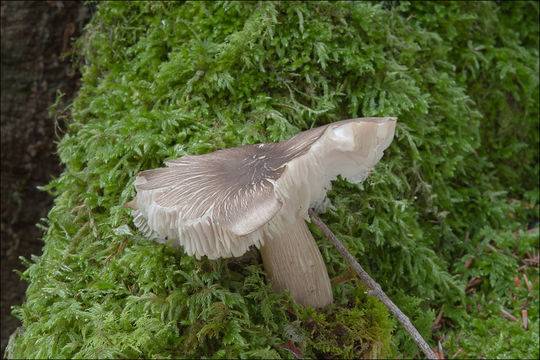Слика од Megacollybia platyphylla (Pers.) Kotl. & Pouzar 1972

Опис:
Slo.: irokolistna velekorenovka - syn.: Collybia platyphylla (Pers.) P. Kumm., Clitocybula platyphylla (Pers.) E. Ludw., Oudemansiella platyphylla (Pers.) Moser, Tricholomopsis platyphya and many others - Habitat: mixed wood, Fagus sylvatica and Picea abies dominant trees with some Ostrya carpinifolia and Fraxinus ornus; slightly inclined mountain slope, SE aspect; old colluvial, calcareous ground, in shade, dry and relatively warm place; partly protected from direct rain by tree canopies; average precipitations ~ 3.000 mm/year, average temperature 7-9 deg C, elevation 600 m (1.950), alpine phytogeographical region.Substratum: heavily rotten, moss covered stump of Fagus sylvatica. Comments: When I noticed this fungus I thought it was a kind of Pluteus (actually Pluteus cervinus (Schaeff.) P. Kumm. looks very similar). However, neither its spore print nor gills showed even a trace of pinkish color. So, it must be almost for sure Megacollybia platyphylla. Its streaked-looking gray-brown cap is typical.Genus Megacollybia was considered monophyletic (that is containing only one specie - Megacollybia platyphylla) not so far ago. Recent DNA sequencing in North America (Ref.3) showed that it can be separated to several distinct species (how many of them scientists do not agree, up to nine worldwide). One of them Megacollybia platyphylla was limited to Europe. Unfortunately newly recognized species in North America cannot practically be separated by macro-morphological traits (particularly not if geographic location is dismissed as a 'character'). They are all variable and all look alike. Even microscopy doesn't help. To determine them in the field one would need 'pocket DNA sequencer' (which doesn't exist). So it is: DNA-defined species do not always show observable differences in physical features. Megacollybia platyphylla is a common mushroom. There are conflicting reports about edibility of it. Some consider it conditionally edible, some weakly poisonous. Description of this find: Growing solitary; heavily eaten by snails; pileus diameter 13 cm, radially streaked, strakes peel off easily; trama thin, gills broad, beige, fragile; stipe 8 cm long, 23 mm in diameter at the base and 19 mm on top, firm, slightly hollow at the center, fibrous, firmly attached to the rotten wood by mycelial strands; smell slightly on sour bread, taste mild, indistinctive; SP faint, beige, oac814.Spores smooth. Dimensions: 7.3 [8 ; 8.3] 9 x 5.9 [6.5 ; 6.8] 7.4 microns; Q = 1.1 [1.2] 1.4; N = 30; C = 95%; Me = 8.1 x 6.7 microns; Qe = 1.2. Olympus CH20, NEA 100x/1.25, magnification 1.000 x, oil; in water, fresh material. AmScope MA500 digital camera.Herbarium: Mycotheca and lichen herbarium (LJU-Li) of Slovenian Forestry Institute, Vena pot 2, Ljubljana, Index Herbariorum LJFRef.: (1) R. Phillips, Mushrooms, Macmillan (2006), p 96. (2) G.J. Krieglsteiner (Hrsg.), Die Grosspilze Baden-Wrttembergs, Band 3., Ulmer (2001), p 360.(3) http://www.mushroomexpert.com/megacollybia.html stanje megacolibija(4) J. Breitenbach, F. Kraenzlin, Eds., Fungi of Switzerland, Vol.3. Verlag Mykologia (1991), p 246. (5) L. Hagar, Ottova Encyklopedia Hb, Ottova Nakladatelstvi, Praha (2015) (in Slovakian), p 673.(6) R. Lueder, Grundkurs Pilzbestimmung, Quelle & Meyer (2008), p 223. (7) S. Buczacki, Collins Fungi Guide, Collins (2012), p 208.
Се јавува на следниве страници:
- Life
- Cellular
- Eukaryota (еукариот)
- Opisthokonta
- Nucletmycea
- Fungi
- Dikarya
- Basidiomycota (Столпчести габи)
- Agaricomycetes (агарикомицети)
- Agaricales (ресести габи)
- Marasmiaceae
- Megacollybia
- Megacollybia platyphylla
Сликата ја нема во ниедна збирка.
Информации за изворот
- лиценца
- cc-by-nc-sa-3.0
- авторски права
- 2017 Dr. Amadej Trnkoczy
- фотограф
- Dr. Amadej Trnkoczy
- изворно
- изворна податотека
- посети извор
- соработничко мреж. место
- CalPhotos
- ID


